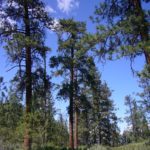Protecting Land
The five parcels that make up Keremeos Columns Grassland contain seven sensitive ecosystems: grasslands, sagebrush steppe, riparian, open coniferous woodland, mature forest, old forest, and sparsely vegetated rocky outcrop. Since low elevated grassland communities are the rarest land cover type in BC, preserving the 138.6 hectares of native open grassland is an urgent conservation priority.
The property is in two biogeoclimatic subzones of provincial conservation concern: Okanagan very dry hot Interior Douglas-fir and Thompson dry cool Interior Douglas-fir. Currently less than 10% of each of these subzones is protected in either parks or conservation areas. More than 80% of the ecological communities described in these subzones are of provincial conservation concern.
Keremeos Columns Grassland is located northeast of the village of Keremeos and southeast of Olalla within the traditional territories of the Smelqmix and Syilx People.
Natural Columns
The Keremeos Columns are vertically hexagonal jointing basalt formations that jut out like narrow rock steps from the surrounding Douglas-fir forest. This geological formation was created approximately 30 million years ago during a period of high volcanic activity. As the molten basalt began to cool and shrink, the basalt rock cracked at 120 degree angles creating the distinctive hexagonal shape we see today.

The Columns of Keremeos Columns Grassland
Saving Species
Vital Habitat
The seven sensitive ecosystems that occur in Keremeos Columns Grassland provide critical habitat to many at risk species and make this property especially sensitive to disturbance.
Watson’s cryptantha, an annual white-flowered, herb grows in the sagebrush steppe, one of only a few known places in BC where it grows naturally. The red-listed Lark Sparrow is largely restricted to the shrub landscape as this is the only habitat type where they nest and breed. Once common in BC, these birds are now primarily found in undisturbed shrub-steppe grasslands of the South Okanagan and Similkameen.

Left to right: Bighorn sheep, Western Rattlesnake, Mule Deer
A majority of this property is designated Critical Habitat for the Western Rattlesnake (SARA Threatened). This blue-listed species relies on low lying vegetation, dead wood, and large rocks for cover and for basking. These ground-dwelling predators are very sensitive to habitat fragmentation, with roads being a leading cause of mortality. The elusive Western Yellow-bellied Racer (SARA Special Concern) has also been spotted within 500 meters of this property. Yellow-bellied Racers are considered to be the fastest snake in Canada and possess unique ecological adaptations to this arid environment. Fragmentation and habitat loss is a leading cause of their population decline, highlighting the value of protecting contiguous parcels of conservation land.
Bighorn Sheep, an iconic species of provincial concern, live in this area. In the winter Mule deer come down from the hills and live on this property.


 000 by April 30th, 2022 to conserve this property
000 by April 30th, 2022 to conserve this property


